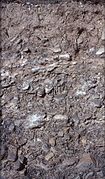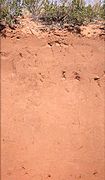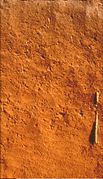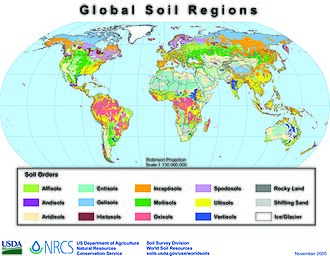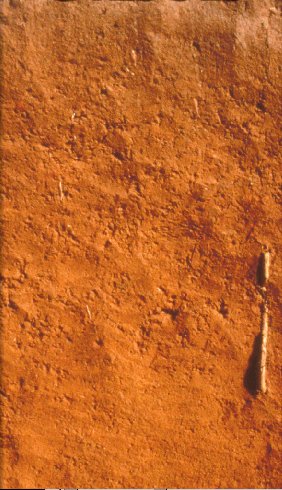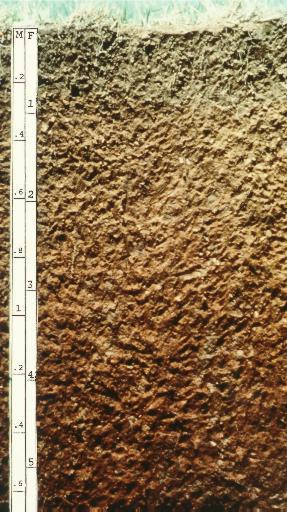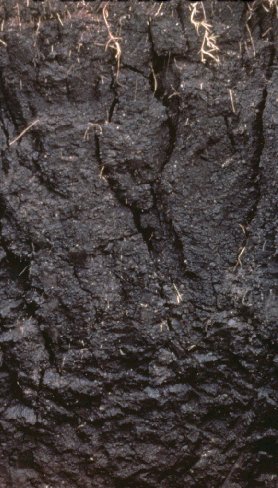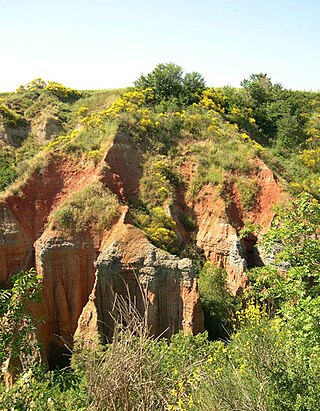Discussion
A taxonomy is an arrangement in a systematic manner; the USDA soil taxonomy has six levels of classification. They are, from most general to specific: order, suborder, great group, subgroup, family and series. Soil properties that can be measured quantitatively are used in this classification system – they include: depth, moisture, temperature, texture, structure, cation exchange capacity, base saturation, clay mineralogy, organic matter content and salt content. There are 12 soil orders (the top hierarchical level) in soil taxonomy. [2] [3] The names of the orders end with the suffix -sol. The criteria for the different soil orders include properties that reflect major differences in the genesis of soils. [4] The orders are:
- Alfisol – soils with aluminium and iron. They have horizons of clay accumulation, and form where there is enough moisture and warmth for at least three months of plant growth. They constitute 10% of soils worldwide.
- Andisol – volcanic ash soils. They are young soils. They cover 1% of the world's ice-free surface.
- Aridisol – dry soils forming under desert conditions which have fewer than 90 consecutive days of moisture during the growing season and are nonleached. They include nearly 12% of soils on Earth. Soil formation is slow, and accumulated organic matter is scarce. They may have subsurface zones of caliche or duripan. Many aridisols have well-developed Bt horizons showing clay movement from past periods of greater moisture.
- Entisol – recently formed soils that lack well-developed horizons. Commonly found on unconsolidated river and beach sediments of sand and clay or volcanic ash, some have an A horizon on top of bedrock. They are 18% of soils worldwide.
- Gelisol – permafrost soils with permafrost within two metres of the surface or gelic materials and permafrost within one metre. They constitute 9% of soils worldwide.
- Histosol – organic soils, formerly called bog soils, are 1% of soils worldwide.
- Inceptisol – young soils. They have subsurface horizon formation but show little eluviation and illuviation. They constitute 15% of soils worldwide.
- Mollisol – soft, deep, dark soil formed in grasslands and some hardwood forests with very thick A horizons. They are 7% of soils worldwide.
- Oxisol – are heavily weathered, are rich in iron and aluminum oxides (sesquioxides) or kaolin but low in silica. They have only trace nutrients due to heavy tropical rainfall and high temperatures and low CEC of the remaining clays. They are 8% of soils worldwide.
- Spodosol – acid soils with organic colloid layer complexed with iron and aluminium leached from a layer above. They are typical soils of coniferous and deciduous forests in cooler climates. They constitute 4% of soils worldwide.
- Ultisol – acid soils in the humid tropics and subtropics, which are depleted in calcium, magnesium and potassium (important plant nutrients). They are highly weathered, but not as weathered as Oxisols. They make up 8% of the soil worldwide.
- Vertisol – inverted soils. They are clay-rich and tend to swell when wet and shrink upon drying, often forming deep cracks into which surface layers can fall. They are difficult to farm or to construct roads and buildings due to their high expansion rate. They constitute 2% of soils worldwide.
- Alfisol
- Andisol
- Aridisol
- Entisol
- Gelisol
- Histosol
- Inceptisol
- Mollisol
- Oxisol
- Spodosol
- Ultisol
- Vertisol
The percentages listed above [5] are for land area free of ice. "Soils of Mountains", which constitute the balance (11.6%), have a mixture of those listed above, or are classified as "Rugged Mountains" which have no soil.
The above soil orders in sequence of increasing degree of development are Entisols, Inceptisols, Aridisols, Mollisols, Alfisols, Spodosols, Ultisols, and Oxisols. Histosols and Vertisols may appear in any of the above at any time during their development.
The soil suborders within an order are differentiated on the basis of soil properties and horizons which depend on soil moisture and temperature. Forty-seven suborders are recognized in the United States. [6]
The soil great group category is a subdivision of a suborder in which the kind and sequence of soil horizons distinguish one soil from another. About 185 great groups are recognized in the United States. Horizons marked by clay, iron, humus and hard pans and soil features such as the expansion-contraction of clays (that produce self-mixing provided by clay), temperature, and marked quantities of various salts are used as distinguishing features. [6]
The great group categories are divided into three kinds of soil subgroups: typic, intergrade and extragrade. A typic subgroup represents the basic or 'typical' concept of the great group to which the described subgroup belongs. An intergrade subgroup describes the properties that suggest how it grades towards (is similar to) soils of other soil great groups, suborders or orders. These properties are not developed or expressed well enough to cause the soil to be included within the great group towards which they grade, but suggest similarities. Extragrade features are aberrant properties which prevent that soil from being included in another soil classification. About 1,000 soil subgroups are defined in the United States. [6]
A soil family category is a group of soils within a subgroup and describes the physical and chemical properties which affect the response of soil to agricultural management and engineering applications. The principal characteristics used to differentiate soil families include texture, mineralogy, pH, permeability, structure, consistency, the locale's precipitation pattern, and soil temperature. For some soils the criteria also specify the percentage of silt, sand and coarse fragments such as gravel, cobbles and rocks. About 4,500 soil families are recognised in the United States. [7]
A family may contain several soil series which describe the physical location using the name of a prominent physical feature such as a river or town near where the soil sample was taken. An example would be Merrimac for the Merrimack River in New Hampshire. More than 14,000 soil series are recognised in the United States. This permits very specific descriptions of soils. [8]
A soil phase of series, originally called 'soil type' describes the soil surface texture, slope, stoniness, saltiness, erosion, and other conditions. [8]


